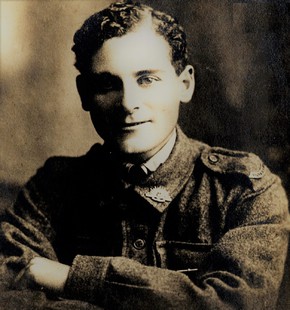
S4029
ROACH, Frank John
| Service Numbers: | 7288, S69573 |
|---|---|
| Enlisted: | 24 January 1917, Adelaide, SA |
| Last Rank: | Private |
| Last Unit: | Volunteer Defence Corps (SA) |
| Born: | Kilkenny, 13 April 1894 |
| Home Town: | Maylands (SA), Norwood Payneham St Peters, South Australia |
| Schooling: | Mount Gambier High School |
| Occupation: | Reader's assistant |
| Memorials: | Mount Gambier High School Great War Roll of Honor |
World War 1 Service
| 24 Jan 1917: | Enlisted AIF WW1, Private, 7288, 10th Infantry Battalion, Adelaide, SA | |
|---|---|---|
| 23 Jun 1917: | Embarked Private, 7288, 10th Infantry Battalion, HMAT Borda, Adelaide | |
| 23 Jun 1917: | Involvement Private, 7288, 10th Infantry Battalion, --- :embarkation_roll: roll_number: '10' embarkation_place: Adelaide embarkation_ship: HMAT Borda embarkation_ship_number: A30 public_note: '' |
World War 2 Service
| 12 Apr 1942: | Enlisted Australian Military Forces (WW2) , Private, S69573, Volunteer Defence Corps (SA), Adelaide, SA |
|---|
Help us honour Frank John Roach's service by contributing information, stories, and images so that they can be preserved for future generations.
Add my storyBiography contributed by Adelaide Botanic High School
Frank John Roach was a single, 22-year-old readers assistant when he enlisted in the AIF on the 24th of January 1917, ranked as a private. Roach was born on the 13th of April 1894 in Kilkenny, South Australia. He lived with his father, Edward Arthur Roach who was his next of kin. Roach’s service number was 7288, he weighed 100 lbs. and stood at a height of 5 foot 4 inches. In the description of Roaches enlistment, he was described as having blue eyes, brown hair, and the religious denomination of the church of England.He embarked with the AIF on the 23rd of June 1917 as a part of the 10th Australian Infantry Battalion. He travelled by boat for 2 months to Plymouth, England, and disembarked Plymouth on the 25th of August 1917.
Roach would proceeded overseas to France on January 8th, 1918, from Plymouth to join the 10th Australian Infantry Battalion.
On the 9th of February 1918, Roach was hospitalised in France with an unknown illness and 12 days later he rejoined the Battalion from the hospital. This is the only recorded time that Roach was in the hospital during WWI.
In Hollebeke, Belgium, Roach was awarded a military medal for bravery in the field in March 1918. Described by the major-general in the medal description, “Through the whole operation he displayed great courage and initiative and yet a splendid example to the other men of the platoon… Under heavy artillery and machine gun fire, he crept out in front of our posts, located our own and enemy wounded and assisted to bring them in.”
During this time from the 1st of March to the 31st of May 1918, the German Spring Offensive battle was taking place in Belgium. This war took place in the exact time and place that Roach received his military medal. From this information it can be inferred that Roach fought with the 10th Infantry Battalion in this battle.
Roach returned home to Australia on the 17th of March 1919. Little is known about Roach’s life after the war, although we do know that he served as apart of the AIF in World War II. On his WWII enlistment forms it is shown that he was married to Kathleen Roach.
Biography contributed by Graeme Roulstone
7288 Frank James ROACH was born at Kilkenny, South Australia, on 13 April 1894 and was enrolled at Mount Gambier High School on 9 October 1908 by his father Edward S Roach, compositor, of Claraville, Mount Gambier. He left school on 22 December 1909.
He enlisted in Adelaide on 24 January 1917 (20, reader’s assistant, single, Church of England) naming his father, Edward Arthur Roach of Maylands, as his next of kin, having previously been rejected because of his foot and a heart murmur. He embarked from Adelaide on the ‘Borda’ on 23 June 1917, disembarked at Plymouth in England on 25 August, where he was attached to the 3rd Training Battalion, then the 2nd Training Battalion.
He went overseas to France on 8 January 1918, and joined the 10th Battalion on 23 January, being hospitalised suffering from hammer toe from 9 to 21 February, and then involved in the operations that halted the German offensive in March and April. He was awarded a Military Medal for his actions on 1-2 March. His commendation reads:
At Hollebeke on night of 1/2 March, 1918, during an enemy raid, Pte. Roach displayed great bravery under very trying conditions. He voluntarily accompanied his platoon commander upon a reconnaissance of the raided area, under heavy artillery and machine gun fire. He crept out in front of our posts, located our own and enemy wounded and assisted to bring them in. Through the whole operation he displayed great courage and initiative and set a splendid example to the other men of the platoon.
He was hospitalised again, this time with influenza from 24 June to 5 July before rejoining the 10th Battalion and taking part in Australian advances near Amiens in August and September. He left England from Liverpool on board the ‘Plassy’ for return to Australia on 17 March 1919, disembarked on 28 April and was discharged on 28 May. He was one of a number of soldiers presented with their decorations for bravery by His Excellency the Governor, Sir Henry Galway, at Government House, Adelaide, on Tuesday 26 August.
Published in Ours: the origins and early years of Mount Gambier High School and Old Scholars who served in the Great European War by Graeme Roulstone











